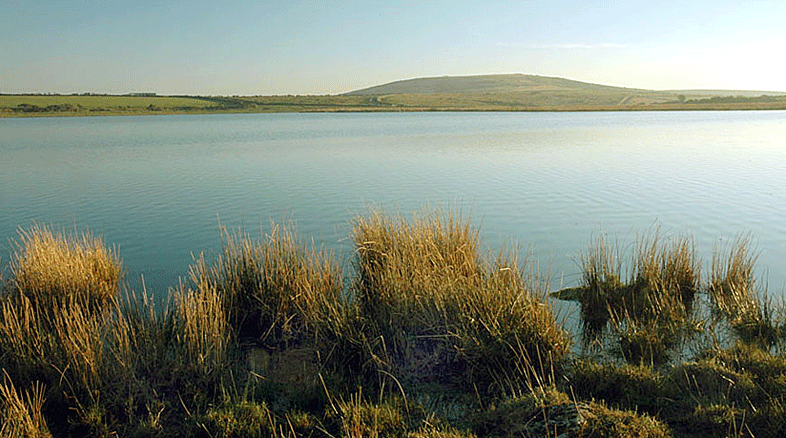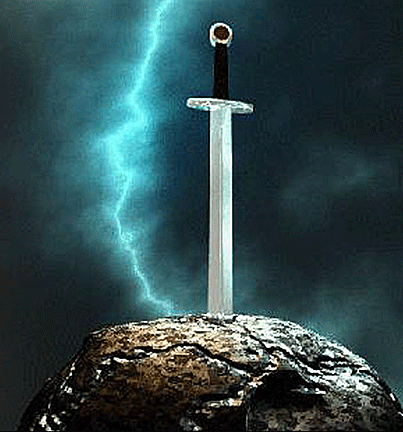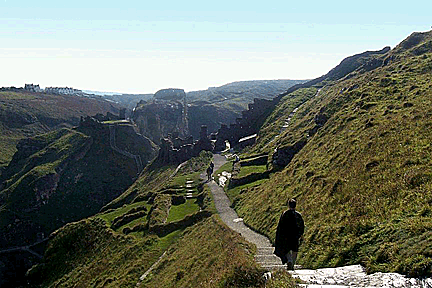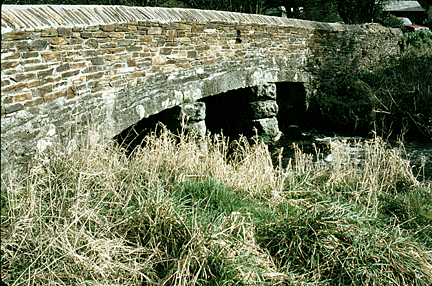|
Afterwards, I headed to Bodmin Moor, two miles south
of Bolventor in Cornwall, to visit Dozmary Pool. A mile in circumference,
Dozmary Pool is a place of changing mood and beauty, a place of mystery and
magic. Standing on its rim as the early morning mist began to rise, I could
imagine Sir Bedivere throwing Excalibur into the lake, from which a hand
rose and caught the magical sword, as King Arthur lay dying.

 The
story of Excalibur being thrown to the Lady of the Lake probably originated
in Celtic practices. Archaeologists have found many swords that have long
ago been thrown into sacred lakes as votive offerings to the water goddess,
the goddess of healing. The
story of Excalibur being thrown to the Lady of the Lake probably originated
in Celtic practices. Archaeologists have found many swords that have long
ago been thrown into sacred lakes as votive offerings to the water goddess,
the goddess of healing.
Popular belief places Arthur's birth at Tintagel Castle on the north cost of
Cornwall, my next stop. The ruins of the castle, itself, stand just outside
the village, on what's virtually an island surrounded by foaming seas, once
linked to the mainland by a narrow ridge of rock.
To get to the ruins, I had to cross a footbridge and ascend a long flight of
steps. The sound of the waves crashing against the rocky shore 250 feet
below was little comfort as I felt the wind, full of the scent of salt air,
nearly push me over. The ruins only hinted at the castle's former grandeur.
All that remains is a dramatic archway and several sections of walls pocked
with holes that used to support building timbers.
 Merlin's
cave supposedly lies directly below the ruins, piercing the great cliff,
cutting through to a rocky beach on the other side of the headland. Here,
under grey skies, the roar of the Atlantic can be as loud as the wind on a
stormy day. At Tintagel the line dividing fact and legend is often thin,
sometimes blurred. Merlin's
cave supposedly lies directly below the ruins, piercing the great cliff,
cutting through to a rocky beach on the other side of the headland. Here,
under grey skies, the roar of the Atlantic can be as loud as the wind on a
stormy day. At Tintagel the line dividing fact and legend is often thin,
sometimes blurred.
The earliest mention of Tintagel in association with King Arthur appears in
Geoffrey of Monmouth's Historia, in which Uther Pendragon falls in love with
Ygerna, wife of Gorlois, Duke of Cornwall. To keep her away from Uther's
grasp, her husband keeps her a prisoner at Tintagel. Infuriated, Uther goes
to Cornwall, persuading Merlin to prescribe a magic brew enabling him to
look like Gorlois. Thus disguised, he has no difficulty in entering the
Castle to sleep with Ygerna. As a result, Arthur is conceived. Gorlois is
defeated and killed in battle with Uther's army, and his wife, now free,
becomes Queen of Britain.
 The
thousands of Arthurian pilgrims who come to Tintagel seem unaffected by the
fact that the present castle was only built in the early 12th century, thus
it couldn't have been Arthur's birthplace. However, archaeologists have
found the remains of a 6th century Celtic monastery founded by St. Juliot on
the site, but there's no evidence to associate it with the legendary king. The
thousands of Arthurian pilgrims who come to Tintagel seem unaffected by the
fact that the present castle was only built in the early 12th century, thus
it couldn't have been Arthur's birthplace. However, archaeologists have
found the remains of a 6th century Celtic monastery founded by St. Juliot on
the site, but there's no evidence to associate it with the legendary king.
Not far from Tintagel stands Slaughter Bridge, near Camelford. Very old, not
arched but built over flat stones on piers, it spans the Camel River, said
to be the true battlefield of Camlann, Arthur's last battle, in which he
kills Mordred with a spear. But the dying Mordred has enough strength to
 raise
his sword and strike his father on the head piercing through his helmet. raise
his sword and strike his father on the head piercing through his helmet.
Upstream in a nook lies a stone with moss and strange lettering which the
Cornish call Arthur's grave. But it's more likely to be that of a Celtic
chieftain.
Arthur's half-sister, Morgan Le Fay, was supposed to have the powers of an
enchantress, including the ability to transform herself into a bird, a
Cornish chough, a sign of prosperity. Local lore says that Arthur didn't die
at Slaughter Bridge, but was instead incarnated into the soul of a chough,
so that he may come again.
Next:
The Vale of Avalon
|
